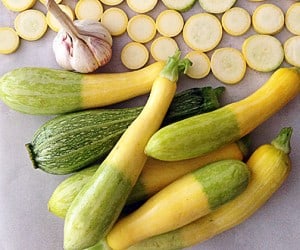A Foodie’s Garden
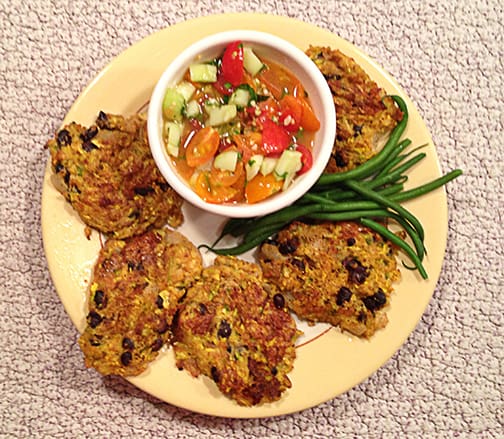
These summer squash and cornmeal cakes made a tasty meal with fresh garden green beans and salsa. I softened cornmeal with some warm water, then combined that with the grated squash, black beans, cilantro, and two beaten eggs.
If you’re a foodie and you’re not growing vegetables I have just five words: what are you waiting for?
OK, maybe I have more than five words, because if you aren’t growing your own, you’re missing out on some seriously good food. We’re talking about freshness and flavor here, not to mention organically grown. These are things I know that you are familiar with and value, so let me recommend a few veggies that I think will transform you from a run-of-the-table foodie into a food-lover who gardens.
If you’re planting vegetables you’ll want to start with one that’s really a fruit: the tomato. Although there are many great tomato varieties to grow (and I encourage everyone to grow several) these two are my must-have types for flavor and fruit production.
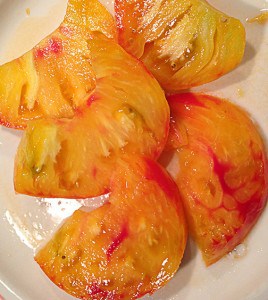
You can see how the pink streaking in Virginia Sweets makes it attractive just sliced on a plate. Combine this with slices of red, green and pink tomato varieties and you have a jewel tone salad!
Virginia Sweets is a bi-color tomato that has been the most delicious and reliable producer in our gardens for the past four years. The fruits are large and the plants prolific. Virginia Sweets are flavorful: great for eating raw, of course, but also tasty for making yellow gazpacho, or golden tomato sauce.
If you can only grow two types of tomatoes, make one of them Sungold. These are cherry type tomatoes and they are so sweet that they frequently never make it from the garden to the table: you’ll pop these in your mouth almost as fast as you can pick them. Fortunately, Sungold plants are usually loaded with fruit so your dinner guests do have some chance of tasting them.
A summer garden isn’t complete without summer squash and I love a variety called Zephyr. The squash are firm and nutty in flavor. I try to pick them small, but even as they grow larger this is a wonderful vegetable. Zephyr impresses me with its vigor; even though the plants in my garden eventually get powdery mildew, the plants keep making new growth, flowers and squash, right up until hard frost.
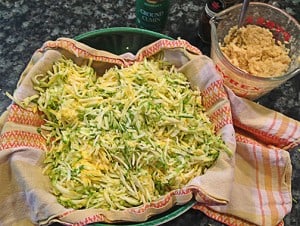
When using summer squash grated, leaving it in a dishtowel for fifteen to twenty minutes drains out some of the excess moisture.
Swiss chard is another of my essential vegetables. You can pick it young for salad or stir-fry, or let it mature and use it in any recipe as you would spinach. Cut it into ribbons for soup, chop it for omlets and stir-fry, or lay it flat and use the large leaves as a pasta substitute in lasagna. Stuff them, steam them, or grind them up into pesto. Delicious.
Fresh lettuce greens are the easiest thing in the world to grow and they can be raised on any size property. Grow them in window boxes on a terrace, in pots on a patio, or along the path to your front door. Plant lettuce in your foundation plantings or perennial beds, and by all means make several sowings in any vegetable garden. Lettuce is one of the few edible crops that does well in part shade, so if your growing space doesn’t have much sun, grow salad.
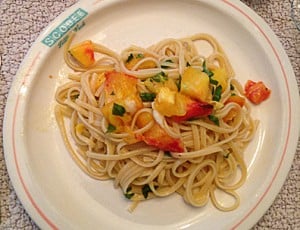
My husband and I call this “Summertime Pasta” – fresh tomatoes, basil, olive oil, garlic and pasta, served with grated parmesan cheese.
We all know that kale is hot with foodies right now, but I think we can also admit that some varieties are tastier than others. If you want a versatile, mild, but distinctive kale, get the Tuscan, aka Italian, variety and eat it cooked or raw. Cut only the largest leaves, leaving the tops, and you’ll be able to harvest it for months.

This summer salad was made with freshly picked tomatoes, cucumbers, arugula, assorted lettuce and nasturtiums. Add some good brie cheese, white beans and croutons, and toss with olive oil and a little vinegar: the most delicious meals on earth.
A foodie’s garden isn’t complete without herbs, of course. These can be purchased as plants at any local garden center, and they can be grown in pots or herb gardens. There are some varieties that are particularly successful in containers; if you want to grow these from seeds, Renee’s Garden offers a collection that’s ideal for pots, boxes or other small spaces.
To finish off my fresh-food-for-foodies list, I urge you to grow nasturtiums. These can be planted in any sunny location and both leaves and flowers are edible. They add a peppery kick to salads and sandwiches and are the perfect garnish for any summer plate or platter. Stick a nasturtium leaf and flower in each bowl of cold-cucumber soup before serving and you will have a visual and culinary treat.
Good growing, and bon appetite!

